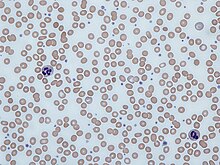Anemia
decrease in number of red blood cells
Anemia (U.S. spelling) or anaemia is not having enough red blood cells or hemoglobin in the blood.


Types or causes of anemia
changeMicrocytic anemia
change- Iron deficiency anemia is the most common type of anemia overall
- Hemoglobinopathies—much rarer
- Sickle-cell disease (once called sickle-cell anemia)
- Thalassemia
Normocytic anemia
change- Acute blood loss
- Anemia of chronic disease
- Aplastic anemia (bone marrow failure)
Macrocytic anemia
change- Megaloblastic anemia due to not having enough of either vitamin B12 or folic acid (or both)
- Pernicious anemia is an autoimmune problem with the parietal cells of the stomach
- Alcoholism
- Methotrexate, zidovudine, and other drugs that stop DNA replication. This is the most common cause in nonalcoholic patients.
Dimorphic anemia
changeDimorphic anemia means two types of anemia at the same time. For example, macrocytic hypochromic, due to hookworm infestation leading to not enough of both iron and vitamin B12 or folic acid or following a blood transfusion.